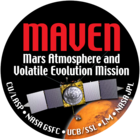Maven

Artist's rendering of the MAVEN spacecraft bus
|
|||||
| Mission type | Mars atmospheric research | ||||
|---|---|---|---|---|---|
| Operator | NASA | ||||
| COSPAR ID | 2013-063A | ||||
| SATCAT № | 39378 | ||||
| Website | NASA MAVEN | ||||
| Mission duration | 1 Earth year. Science phase extended through September 2016. Additional 6 years as telecomm relay (planned). |
||||
| Spacecraft properties | |||||
| Manufacturer |
Lockheed Martin CU-Boulder Berkeley NASA GSFC |
||||
| Launch mass | 2,454 kg (5,410 lb) | ||||
| Dry mass | 809 kg (1,784 lb) | ||||
| Payload mass | 65 kg (143 lb) | ||||
| Power | 1,135 watts | ||||
| Start of mission | |||||
| Launch date | November 18, 2013, 18:28 UTC | ||||
| Rocket | Atlas V 401 AV-038 | ||||
| Launch site | Cape Canaveral SLC-41 | ||||
| Contractor | United Launch Alliance | ||||
| Orbital parameters | |||||
| Reference system | Areocentric (Mars) | ||||
| Periareion | 150 km (93 mi) | ||||
| Apoareion | 6,200 km (3,900 mi) | ||||
| Inclination | 75 degrees | ||||
| Period | 4.5 hours | ||||
| Epoch | Planned | ||||
| Mars orbiter | |||||
| Orbital insertion | September 22, 2014, 02:24 UTC MSD 50025 08:07 AMT |
||||
|
|||||
Mars Atmosphere and Volatile EvolutioN Mission (MAVEN) is a space probe developed by NASA designed to study the Martian atmosphere while orbiting Mars. Mission goals include determining how the planet's atmosphere and water, presumed to have once been substantial, were lost over time.
MAVEN was successfully launched aboard an Atlas V launch vehicle at the beginning of the first launch window on November 18, 2013. Following the first engine burn of the Centaur second stage, the vehicle coasted in low Earth orbit for 27 minutes before a second Centaur burn of five minutes to insert it into a heliocentric Mars transit orbit.
On September 22, 2014, MAVEN reached Mars and was inserted into an areocentric elliptic orbit 6,200 km (3,900 mi) by 150 km (93 mi) above the planet's surface. The principal investigator for the spacecraft is Bruce Jakosky of the Laboratory for Atmospheric and Space Physics at the University of Colorado Boulder.
On 5 November 2015, NASA announced that data from MAVEN shows that the deterioration of Mars’ atmosphere increases significantly during solar storms. That loss of atmosphere to space likely played a key role in Mars' gradual shift from its carbon dioxide-dominated atmosphere - which had kept Mars relatively warm and allowed the planet to support liquid surface water - to the cold, arid planet seen today. This shift took place between about 4.2 to 3.7 billion years ago.
...
Wikipedia

